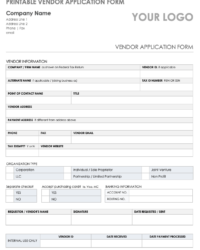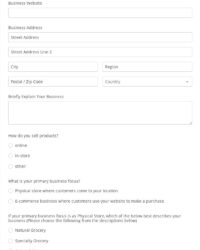Utilizing a pre-structured form offers several advantages. It promotes efficiency by providing a clear framework for information gathering, reducing the likelihood of missing critical data. This standardized approach also simplifies vendor comparisons, allowing businesses to objectively assess potential partners based on consistent criteria. Furthermore, it contributes to compliance and risk management by ensuring necessary information for due diligence is collected from the outset.
The following sections will explore the key components of these forms, best practices for their creation and implementation, and strategies for leveraging them effectively within procurement workflows. Further discussion will also address common challenges and provide solutions for optimizing their use.
Key Components of a Vendor Application Form
Effective vendor application forms gather comprehensive information for thorough evaluation. Key components ensure consistent data collection and facilitate informed decision-making.
1. Business Identification: This section captures essential details about the vendor’s legal identity, including the company name, address, contact information, and website. Tax identification numbers and business registration details are also typically required.
2. Business Structure and Ownership: Information on the vendor’s legal structure (e.g., sole proprietorship, partnership, corporation) and ownership details is crucial for understanding potential liabilities and compliance requirements.
3. Financial Information: This component requests financial data, such as annual revenue, credit references, and banking details, to assess the vendor’s financial stability and creditworthiness.
4. Experience and Capabilities: Details about the vendor’s experience, including years in business, client portfolio, and relevant certifications, help evaluate their expertise and suitability.
5. Products and Services Offered: A clear description of the products or services offered allows businesses to determine alignment with their specific needs.
6. References: Contact information for client references provides valuable insights into the vendor’s past performance and reputation.
7. Insurance and Liability: Information on insurance coverage and liability policies protects businesses from potential risks associated with vendor engagement.
8. Legal Compliance: This section may include questions about compliance with relevant regulations, such as labor laws, environmental standards, and industry-specific requirements.
Collecting this comprehensive data provides a solid foundation for vendor selection, fostering strong business relationships built on transparency and trust.
How to Create a Vendor Application Template
Developing a comprehensive vendor application template requires careful consideration of specific business needs and industry best practices. A well-structured template streamlines vendor onboarding, ensures consistent data collection, and facilitates informed decision-making.
1. Define Objectives: Clearly outline the purpose of the application and the information required to evaluate potential vendors effectively. Consider specific industry regulations and internal procurement policies.
2. Structure the Template: Organize the template logically into sections, using clear headings and subheadings. Group related information together to facilitate easy navigation and completion.
3. Include Essential Information Fields: Incorporate fields for capturing key data points, such as business identification, financial information, experience, capabilities, products/services offered, references, insurance, and legal compliance. Ensure all required fields are clearly marked.
4. Choose the Right Format: Select a format that allows for easy completion and efficient data processing. Digital formats, such as online forms or fillable PDFs, offer advantages in terms of accessibility and data management.
5. Test and Refine: Pilot test the template with a small group of vendors to identify any areas for improvement. Gather feedback and refine the template to ensure clarity and usability.
6. Implement and Maintain: Integrate the finalized template into procurement processes. Regularly review and update the template to reflect evolving business needs and regulatory changes.
7. Ensure Accessibility: Provide the template in accessible formats, accommodating diverse needs and ensuring inclusivity in the vendor selection process.
8. Maintain Confidentiality: Establish secure procedures for handling completed applications to protect sensitive vendor information and maintain confidentiality.
A robust template serves as a valuable tool for managing vendor relationships, mitigating risks, and promoting successful partnerships. A well-designed template facilitates effective evaluation and selection, contributing to a more streamlined and efficient procurement process.
Standardized forms for prospective supplier information are essential for efficient procurement. These forms provide a structured approach to gathering crucial data points, including business details, financial stability, experience, and compliance information. This systematic process enables objective vendor comparisons, informed decision-making, and reduced risk. A well-designed template ensures consistency in data collection, streamlines the onboarding process, and facilitates thorough due diligence.
Effective vendor management is crucial for organizational success. Leveraging standardized application forms empowers businesses to build strong, reliable supplier relationships based on transparency and trust. By implementing these practices, organizations can optimize procurement processes, mitigate potential risks, and foster mutually beneficial partnerships that contribute to long-term growth and stability.


